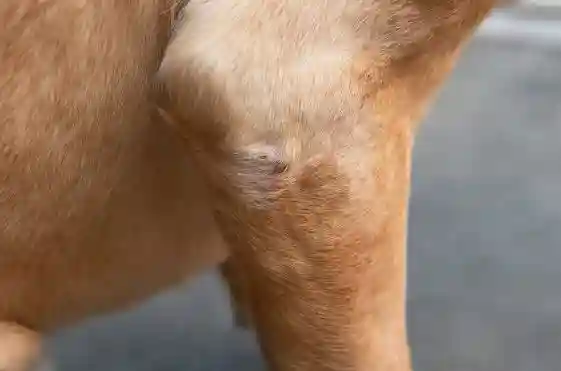In the world of pet care, dog owners often encounter various challenges. One common issue that plagues our beloved furry friends is the incessant scratching on their faces. As dog lovers and experienced pet care professionals, we understand the concern and frustration that can arise when your canine companion starts scratching their face excessively. In this comprehensive guide, we will delve into the reasons behind ‘Dog Face Scratching‘, preventive measures you can take, and effective ways to manage it. Our aim is to equip you with the knowledge and tools needed to ensure your dog’s comfort and well-being.
Why do dogs rubbed faces?
Before we dive into solutions, it’s important to understand why dogs rub or scratch their faces. Several factors can trigger this behavior, including:
Dog Skin Irritations and Allergies: Dog Face Scratching

Allergies to certain foods, plants, or environmental factors can lead to skin irritations in dogs, resulting in intense itching. Dogs often use their paws or claws to scratch their faces when they experience discomfort.
Skin Irritations and Allergies in Dogs: Understanding the Causes and Effects

- Allergic Reactions: Dogs, like humans, can develop allergies to various substances, including food, pollen, dust mites, and certain chemicals. When a dog’s immune system overreacts to these allergens, it can lead to skin irritations.
- Symptoms: Skin irritations and allergies often manifest through symptoms such as redness, itching, swelling, and discomfort. Dogs may scratch their faces vigorously in an attempt to relieve the itching, which can worsen the condition.
- Common Allergens: Common allergens for dogs include certain proteins found in food, grasses, tree pollen, mold spores, and even flea saliva. Identifying the specific allergen is crucial for effective treatment.
- Food Allergies: Food allergies can cause skin problems in dogs. Common food allergens include beef, chicken, dairy, wheat, and soy. Veterinarians often recommend switching to a hypoallergenic diet to alleviate food-related skin issues in pets.
- Environmental Allergies: Environmental allergens like pollen and dust mites can trigger allergic reactions in dogs. These allergens are often harder to control, but measures like keeping your home clean and using air purifiers can help.
- Contact Allergies: Some dogs can develop allergies to substances they come into direct contact with, such as certain grooming products, fabrics, or cleaning agents. Switching to hypoallergenic products can prevent skin irritations.
- Diagnosis: A veterinarian can perform tests, such as skin allergy testing or blood tests, to identify the specific allergen causing the reaction. This is crucial for targeted treatment.
- Treatment: Treatment options for skin irritations and allergies may include antihistamines, corticosteroids, or immunotherapy (allergy shots). Your veterinarian will recommend the most suitable treatment based on the diagnosis.
- Prevention: Preventing skin irritations and allergies often involves allergen management. This may include keeping your dog away from known allergens, using hypoallergenic products, and maintaining a clean living environment.
- Regular Monitoring: If your dog is prone to allergies, it’s essential to monitor their skin condition regularly and seek prompt veterinary care if symptoms worsen or recur.
Parasites: Dog Face Scratching
Parasites like fleas and ticks are common culprits behind excessive scratching. These tiny pests can infest your dog’s fur and cause irritation, particularly on their face and ears.
Parasites in Dogs: Understanding the Problem and Finding Solutions
- Types of Parasites: Dogs can be susceptible to various parasites, with the most common ones being fleas, ticks, mites, and worms. These parasites can infest your dog’s fur, skin, ears, and internal organs, leading to various health issues.
- Skin Irritations: Fleas and ticks are external parasites that can cause intense itching and skin irritations. Dogs often scratch their faces and ears when infested with these parasites, as they seek relief from the discomfort.
- Health Risks: Beyond skin irritations, parasites can pose significant health risks to dogs. For instance, fleas can transmit diseases, while ticks are known carriers of Lyme disease and other pathogens. Internal parasites like worms can lead to digestive problems and malnutrition.
- Prevention: Preventing parasite infestations is crucial. This involves using regular flea and tick prevention methods, which can include topical treatments, collars, or oral medications. Consult your veterinarian to determine the most suitable prevention plan for your dog.
- Regular Inspection: It’s essential to inspect your dog’s fur regularly, especially after outdoor activities. Look for signs of fleas, ticks, or mites, such as small black or brown specks (flea dirt) on the skin.
- Tick Removal: If you find a tick on your dog, it’s vital to remove it promptly and correctly. Use fine-tipped tweezers to grasp the tick as close to the skin’s surface as possible and pull upward with steady, even pressure. Clean the area and your hands thoroughly afterward.
- Ear Mites: Ear mites are common parasites that can cause ear infections and intense itching in dogs. If your dog displays symptoms like head shaking or pawing at the ears, consult your veterinarian for diagnosis and treatment.
- Worm Infestations: Internal parasites like roundworms, tapeworms, and heartworms can be life-threatening if left untreated. Regular deworming and preventive medications are essential to keep these parasites at bay. Consult your veterinarian for a deworming schedule tailored to your dog’s needs.
- Hygiene: Maintaining good hygiene for your dog is also crucial to parasite prevention. Regular baths and grooming can help detect and remove external parasites and keep your dog’s coat and skin healthy.
- Year-Round Protection: Parasites can be active year-round in many regions. Therefore, it’s often recommended to provide your dog with continuous protection, even during the colder months.
- Professional Guidance: If you suspect your dog has a parasite infestation or if you’re unsure about prevention methods, consult your veterinarian. They can provide guidance on the most effective parasite control measures and recommend appropriate treatments.
Ear Infections: Dog Rubbing Ear

Ear infections can cause discomfort that extends to the face. Dogs may scratch their ears and faces in an attempt to alleviate the pain or itchiness.
Ear Infections in Dogs: Causes, Symptoms, and Effective Management
- Common Causes of Dog Ear Infections: Ear infections in dogs can occur due to various factors, but they are often linked to:
- Bacterial Infections: Bacteria can multiply in the ear canal, leading to infections. Moisture, allergies, or ear mites can create a favorable environment for bacterial growth.
- Yeast Infections: Yeast, such as Malassezia, can overgrow in the ear canal, causing itching, inflammation, and discomfort.
- Foreign Objects: Sometimes, foreign objects like grass seeds or debris can become lodged in the ear canal, leading to irritation and infection.
- Allergies: Allergies, whether food or environmental, can increase a dog’s susceptibility to ear infections.
- Anatomy: Dogs with floppy ears or those with narrow ear canals are more prone to ear infections as their ears may not allow proper airflow, trapping moisture and debris.
- Recognizing the symptoms: Early detection is essential for effective treatment. Common symptoms of ear infections in dogs include:
- Head-Shaking: Dogs with ear infections often shake their heads vigorously as a way to relieve discomfort.
- Dog Ear Scratching: Excessive scratching of the ears or rubbing them against furniture is a common sign of ear problems.
- Ear Odor: An unpleasant odor from the ears can indicate an infection.
- Redness and Swelling: The ear may appear red and swollen, and there can be discharge.
- Pain or discomfort: Dogs may show signs of pain when you touch their ears or when they are eating.
- Seek Veterinary Care: If you suspect your dog has an ear infection, it’s crucial to consult a veterinarian. They will perform a thorough examination, including an ear swab and microscopic analysis, to determine the cause of the infection.
- Treatment Options: Treatment for ear infections may include:
- Medications: Depending on the diagnosis, your veterinarian may prescribe antibiotics for bacterial infections or antifungal medications for yeast infections.
- Ear Cleaning: Cleaning the ear canal is often necessary to remove debris and allow medications to work effectively. Your veterinarian will guide you on the proper technique.
- Pain Management: If your dog is in pain, your veterinarian may recommend pain relief medications.
- Underlying Causes: Addressing any underlying causes, such as allergies, is essential to prevent recurrent infections.
- Preventing Ear Infections:
- Regular Cleaning: Regular ear cleaning can help prevent wax buildup and moisture retention. Consult your veterinarian for guidance on safe cleaning practices.
- Allergy Management: If your dog has allergies, work with your veterinarian to manage them effectively. Allergy management can reduce the risk of ear infections.
- Proper grooming: Keeping the hair around your dog’s ears trimmed can help promote airflow and prevent debris from accumulating.
- Follow-up Care: After treatment, it’s essential to follow your veterinarian’s instructions carefully. Attend follow-up appointments as recommended to ensure the infection is completely resolved.
- Routine check-ups: Regular veterinary check-ups can help catch potential ear issues early. Your veterinarian can examine your dog’s ears as part of their routine care.
Dogs Dry Skin: Dog Face Scratching
Just like humans, dogs can suffer from dry skin, especially in dry or cold climates. Dry skin can lead to itching, prompting your dog to scratch their face.

Dry Skin in Dogs: Causes, Symptoms, and Effective Solutions
- Causes of Dog Dry Skin:
- Weather Conditions: Just like humans, dogs can suffer from dry skin, especially in dry or cold climates. Low humidity and harsh weather can strip moisture from their skin.
- Over-bathing: Frequent bathing with harsh shampoos can remove natural oils from a dog’s skin, leading to dryness.
- Allergies: Allergies to certain foods, environmental factors, or grooming products can contribute to dry skin in dogs.
- Nutritional Deficiencies: Inadequate nutrition or a lack of essential fatty acids in a dog’s diet can affect their skin health.
- Underlying Medical Conditions: Dry skin can sometimes be a symptom of underlying medical issues, such as thyroid problems or autoimmune diseases.

- Recognizing the Symptoms:
- Flakiness: Dry skin often leads to flakiness, with visible white or gray flakes on the dog’s fur or bedding.
- Itching: Dogs with dry skin may scratch or lick themselves excessively in an attempt to alleviate itching.
- Redness: Dry skin can cause redness and inflammation, making the affected areas appear irritated.
- Dull Coat: A healthy coat is often a reflection of healthy skin. Dry skin can lead to a dull, lackluster coat.
- Sores or Scabs: In severe cases, dry skin can result in sores or scabs, which may become infected if left untreated.
- Effective Solutions:
- Proper Hydration: Ensure your dog has access to fresh, clean water at all times. Staying well-hydrated is essential for healthy skin.
- Balanced Diet: Provide your dog with a well-balanced diet that includes essential fatty acids like Omega-3 and Omega-6. These nutrients support skin health. Consult your veterinarian for dietary recommendations.
- Moisturizing Shampoo: Use a moisturizing or hypoallergenic dog shampoo during bath time. Avoid over-bathing, as excessive washing can strip natural oils. Only bathe your dog as necessary. Avoid doing so more than once a month unless your veterinarian advises otherwise.
- Supplements: Your veterinarian may recommend supplements containing Omega-3 and Omega-6 fatty acids to improve skin health. These supplements can come in the form of capsules or added to the dog’s food.
- Humidifier: In dry climates, using a humidifier indoors can help maintain the moisture level in the air, benefiting both you and your dog.
- Regular Grooming: Regular brushing helps distribute natural oils in your dog’s coat, preventing dryness and flakiness.
- Allergy Management: If allergies are the cause of dry skin, work with your veterinarian to identify and manage the allergens.
- Consult a Veterinarian: If your dog’s dry skin continues or gets worse, or if you notice other worrying symptoms, make sure to consult your veterinarian. They can perform tests to rule out underlying medical conditions and provide tailored treatment recommendations.
Dog Anxiety and Stress: Dog Face Scratching
Believe it or not, dogs can experience stress and anxiety, which may manifest as compulsive behaviors such as face scratching. Identifying the root cause of their anxiety is key to resolving this issue.

Anxiety and Stress in Dogs: Understanding, Identifying, and Managing
- Understanding Anxiety and Stress:
- Normal vs. Abnormal Anxiety: It’s important to differentiate between normal situational anxiety, such as fear during thunderstorms or fireworks, and chronic or abnormal anxiety, which can affect a dog’s daily life and well-being.
- Causes of Anxiety and Stress: Dogs can experience anxiety and stress for various reasons, including separation from their owners, loud noises, new environments, unfamiliar people or animals, past traumatic experiences, or changes in routine.
- Symptoms of Anxiety and Stress: These can manifest in different ways, including excessive barking, whining, panting, pacing, trembling, hiding, destructive behavior, or changes in appetite and sleep patterns.
- Identifying Triggers:
- Understanding what triggers your dog’s anxiety is crucial for effective management. It can be specific situations, like car rides or visits to the vet, or more general issues, such as separation anxiety when you leave home.
- Keep a journal to record when and where your dog displays signs of anxiety. This can help pinpoint patterns and potential triggers.
- Effective Management Strategies:
- Positive Reinforcement: Use positive reinforcement techniques to reward calm behavior and create positive associations with anxiety triggers. This can involve treats, toys, or praise when your dog remains calm in anxiety-inducing situations.
- Desensitization and Counterconditioning: Gradual exposure to anxiety triggers in a controlled and positive way can help your dog become more accustomed to them. For example, if your dog is anxious around new people, introduce them slowly and with rewards for good behavior.
- Routine and Predictability: Dogs thrive on routine and predictability. Establishing a consistent daily schedule can help reduce anxiety by giving your dog a sense of security.
- Safe Spaces: Create a safe and comfortable space for your dog where they can retreat when feeling stressed. This can be a designated room or a cozy crate.
- Physical and Mental Exercise: Regular exercise and mental stimulation through activities like puzzle toys or obedience training can help reduce anxiety and excess energy.
- Calming Supplements or Medications: Consult your veterinarian about the potential use of calming supplements or medications if your dog’s anxiety is severe. These should only be used under professional guidance.
- Behavioral Training: Consider working with a professional dog trainer or behaviorist who specializes in anxiety-related issues. They can provide tailored strategies and techniques.
- Seek Professional Help:
- If your dog’s anxiety or stress is severely affecting their quality of life or causing aggressive behavior, consult with a veterinarian or a board-certified veterinary behaviorist for a thorough assessment and customized treatment plan.
- Patience and Understanding:
- Remember that managing anxiety and stress in dogs may take time. Be patient and compassionate toward your furry friend throughout the process. Understanding their triggers and working together can lead to significant improvements in their well-being.
Preventive Measures: Keeping Your Dog’s Face Scratch-Free
Prevention is always better than cure. Here are some proactive steps you can take to keep your dog from scratching their face excessively:
Regular Grooming: Maintaining proper grooming habits for your dog is essential. Regular brushing helps distribute natural oils, preventing dry skin. Additionally, grooming sessions provide an opportunity to check for signs of parasites or skin issues.
High-Quality Diet: Ensure your dog receives a balanced diet rich in essential nutrients. Some dogs may develop allergies to certain ingredients, so consult your veterinarian to choose the right food for your pet.
Allergen Management: Identify and eliminate allergens that may trigger skin reactions in your dog. This may include changing cleaning products, avoiding specific plants, or opting for hypoallergenic bedding.
Parasite Prevention: Use effective flea and tick prevention methods recommended by your veterinarian. Regularly inspect your dog’s fur and consult a professional if you suspect an infestation.
Stress Reduction: If your dog’s face scratching appears to be related to stress or anxiety, consider methods to reduce their anxiety levels. This might include behavioral training or consulting a canine behavior specialist.
Managing Dog Face Scratching: Effective Solutions
Sometimes, despite our best efforts, dogs may still scratch their faces. In such cases, it’s essential to know how to manage the issue effectively:
Consult a veterinarian: If your dog’s face scratching persists or worsens, seek professional guidance. A veterinarian can diagnose the underlying cause and recommend appropriate treatments.
Medications and Topical Treatments: Depending on the diagnosis, your veterinarian may prescribe medications or topical treatments to alleviate itching and discomfort. Follow their instructions carefully.
E-Collars: E-collars, or Elizabethan collars, can prevent dogs from reaching their faces to scratch. While they may seem uncomfortable, they can be highly effective in preventing further irritation.
Regular Ear Cleaning: If ear infections are the root cause, your veterinarian may recommend a regular cleaning routine using prescribed ear cleaners.
Conclusion: Dog Face Scratching
Excessive dog face scratching can be a distressing issue, but with the right knowledge and proactive measures, it can be managed effectively. Remember to consult your veterinarian for a proper diagnosis and treatment plan. By prioritizing your dog’s well-being, you can ensure they live a comfortable and itch-free life.
Frequently Asked Questions (FAQs)
What are the common causes of dog face scratching?
Dog face scratching can result from various causes, including allergies, skin irritations, ear infections, parasites, or dry skin. Understanding the underlying issue is key to finding an effective solution.
How can I prevent my dog from excessive face scratching?
Preventing excessive face scratching involves maintaining good hygiene, regular grooming, providing a balanced diet, using parasite prevention methods, and addressing potential allergens. Our blog provides detailed insights into each prevention method.
When should I seek professional help for my dog’s face scratching?
If your dog keeps scratching its face, gets worse, or shows redness, swelling, or discharge, it’s important to see a vet. They can diagnose the underlying cause and recommend appropriate treatment.
How can I help my dog overcome separation anxiety?
Overcoming separation anxiety often requires a gradual de-sensitization process. Start by leaving your dog for short periods, gradually extending the time. Use positive reinforcement and create a safe, comfortable space for them when you’re away. Professional guidance may also be beneficial.
Are there natural remedies for reducing my dog’s stress?
Yes, some natural remedies can help reduce your dog’s stress. These include providing a consistent routine, regular exercise, mental stimulation, and the use of calming supplements like chamomile or CBD oil. However, always consult with your veterinarian before introducing any new supplements or treatments.






